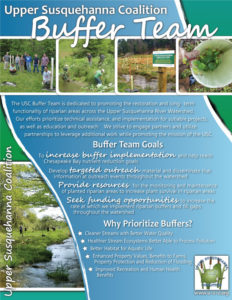USC Buffer Team
The goal of the USC Buffer Team is to promote the restoration and long-term functionality of riparian areas for water and habitat quality. These goals are achieved through innovative programming. The team is dedicated to ensuring practice functionality through education, outreach, and technical assistance.
Data collection to better understand buffer functionality is also a priority as is proving technical support of buffer issues to USC members. We strive to engage partners and utilize partnerships to leverage additional work to promote the mission of the USC.
2025 Buffer Team Goals
- Continue to engage with partners and contractors regarding buffer stewardship.
- Prioritize riparian restoration in areas where there are long term protections and easements.
- Advocate for support for SWCDs in their technical capacity and knowledge of reforestation planning and implementation.
- Secure native stock for Trees for Tributaries.
Targeted 2025 Projects
Our goals are to sustain and bolster the buffer steward program with the intent of getting more maintenance done on newer projects. We’d like to obtain larger stock for projects so we can get some visible shade on streams faster. Since there are some new faces, we’re hoping to collaborate with partners on trainings for new and existing buffer team staff. Look out for Water Quality Symposium forestry track courses, a Plant Materials Center training in May, and the Pennsylvania Buffer Summit in June. Lastly, we are going to continue building staff capacity throughout the watershed.
Buffer Team Events
Buffer Team News
South Lebanon Brook Restoration
Project Background: Located in southern Madison county is a mixed-use beef and crop farm. An un-buffered reach of
USC Buffer Team Partners with Trees for Tribs
2018 Trees for Tribs Summary Since 2007, New York State's Trees for Tribs Program has been working
Stop the Spread: Oak Wilt
By: Laura Grant, USC Buffer Team Background: Oak Wilt is yet another pest threatening the health of our
Cover Photo: Chesapeake Bay Program





